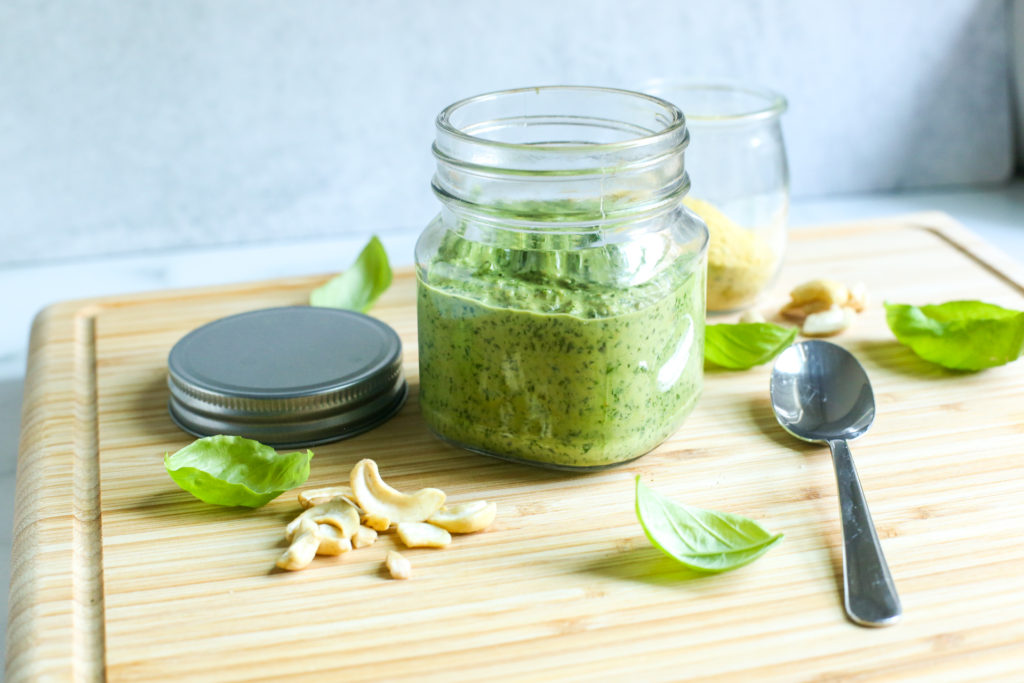
Today, I wanted to share my formula for making pesto.
I’ve been making pesto ever since high school. Back then I loved super creamy and cheesy pesto, while nowadays I opt for dairy free, but still creamy, renditions.
Even though my taste buds and dietary wants have changed a lot over time, pesto is so versatile that I still used the same basic recipe formula that I did in high school.
To make basil, you’ll want:
- Greens. Traditionally basil, but a mix of arugula, parsley, mint, kale, and spinach can deepen the flavor of your pesto.
- Nuts. Traditionally pine nuts, but I usually use cashews because I tend to keep them around more reliably. Other options include almonds, pecans, and walnuts. For a more nutty flavor, chose pecans or walnuts, and to keep the nut flavor mild, pick almonds or cashews. Alternatively, use sunflower seeds if you have a nut allergy!
- “Cheese”: I say cheese very lightly, because while in the past I would load my pesto up with parmesan, nowadays I use nutritional yeast. This is an optional ingredient and can be omitted, but I like the complexity (umami) it adds.
- Fat: Traditionally olive oil, which works wonderfully for pasta, but I love using vegan mayo instead. I think it makes the pesto better for spreading on sandwiches and pizza. If I’m feeling lighter pesto, I’ll use avocado. And if I’m feeling even lighter pesto, I’ll omit the fat entirely and use water or frozen peas. Funnily, the sweetness of peas really compliments pesto.
- Garlic. This one is to taste. I usually use one clove of garlic and a generous sprinkling of garlic powder, though sometimes I’ll just use fresh garlic, or even just powdered if I’m feeling especially lazy.
- Salt. How you introduce salt is totally up to you, but I personally find that a teaspoon of miso paste plus salt to taste works wonders. Traditional pesto would call for plain sea salt.
- Acid. This one is optional, but I think a squeeze of lemon juice or teaspoon of vinegar helps brighten pesto.

And then for *my* perfect ratio (feel free to experiment, because it’s seriously hard to mess up):
- 1 1/2 cup greens
- 1/4 cup nuts and/or seeds
- 2 tbsp “cheese”
- 1 clove garlic
- salt, to taste
- 2 tbsp fat (this one is low compared to traditional pesto, but I don’t like super oily sauces. feel free to increase to 1/4 cup if you do!)
- (optional: 1 tsp acid)
As long as you don’t deviate wildly from this ratio (and honestly, probably even if you do), your pesto will be delicious. The only other equipment you need is a food processor or good ole mortar and pestle (a serious pain in the butt to make, but molecularly superior, maybe), and twenty minutes.
I highly recommend you go pick up some basil (or a basil plant), and try this recipe asap.

easy vegan pesto spread
- 1 1/2 cups (really) packed greens (i used 1 cup basil, 1/2 cup arugula. other options are kale, spinach, parsley. to get the traditional pesto taste, make sure to use at least 1/2 cup basil)
- 1/4 cup nuts, I usually use raw cashews, but other options include: pine nuts, almonds, pecans, walnuts, sun flower seeds
- 1 garlic clove, roughly chopped (+ optional: 1/2 tsp garlic powder)
- 2 tbsp nutritional yeast
- 2 tbsp vegan mayo, oil, or avocado. i chose mayo.
- 1/2-1 tsp salt, to taste. optionally, 1 tsp miso with salt to taste
- (optional: lemon juice, to taste)
- roast the cashews until lightly golden brown, and then set aside to cool. either roast at medium heat on a frying pan, or at 400 degrees for 5-7 minutes. optionally, use an air fryer at 375 for 3 minutes.
- add your greens to a colander or strainer, and turn your sink water to as hot as it goes.
- quickly rinse the greens with the hot water, essentially ‘blanching’ them. this will prevent your pesto from losing its vibrant green color when you store it. then, turn your water to cold to cool down the green.
- shake your greens to dry. try to remove any excess water, but the leaves should still be damp.
- add the greens, cashews, garlic, and nutritional yeast to a food processors, and pulse until finely chopped.
- add the vegan mayo, and salt to taste, and continue processing until the pesto is as chunky or smooth as you prefer. I like a relatively creamy pesto, with just a touch of texture for sandwiches or pizza sauce, but leave it a bit more chunky when I plan to use it for pasta. if you find the mixture is too thick, thin with more vegan mayo, oil, or water.
- to store, refrigerate in a jar or container for up to 5 or so days, or to your own discretion. if it smells and taste alright, it’s probably fine.

